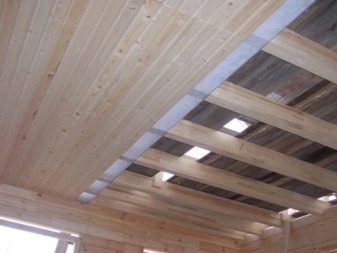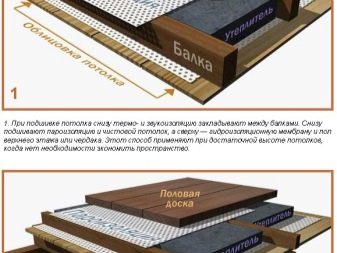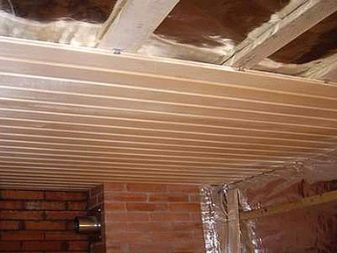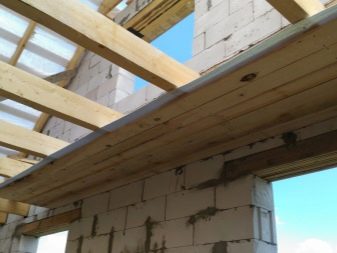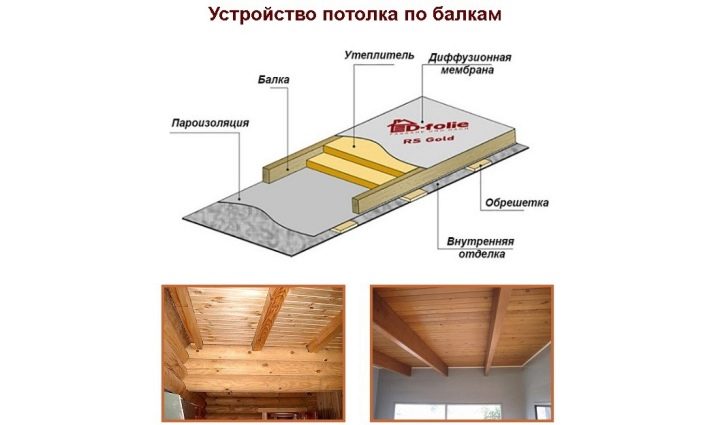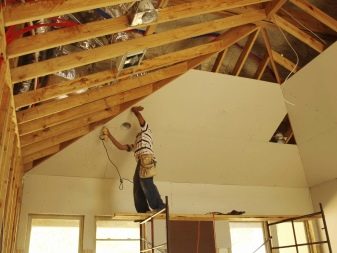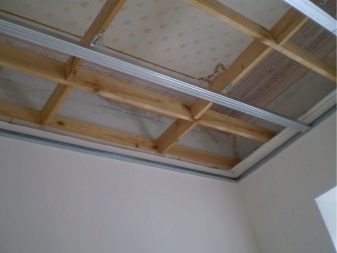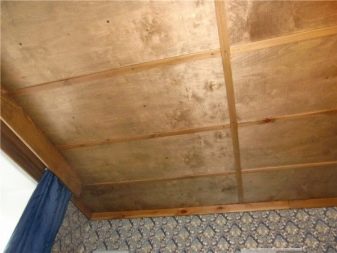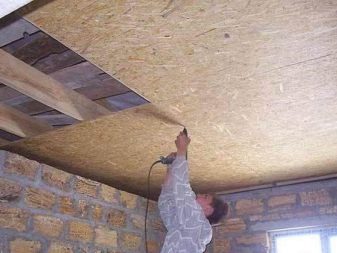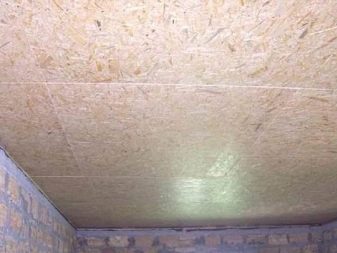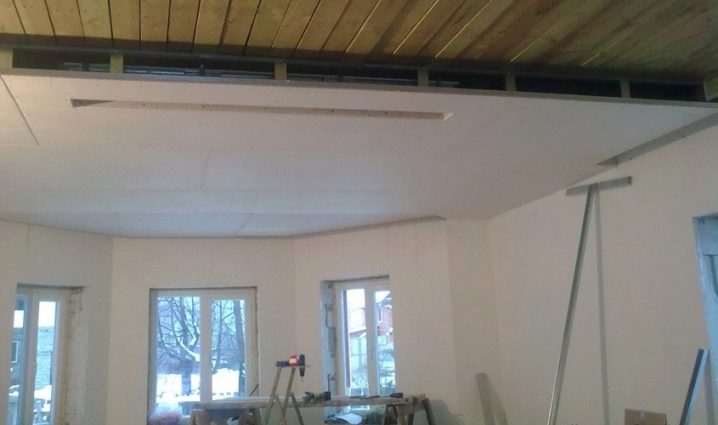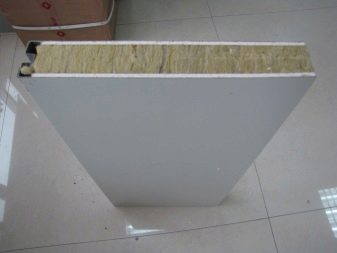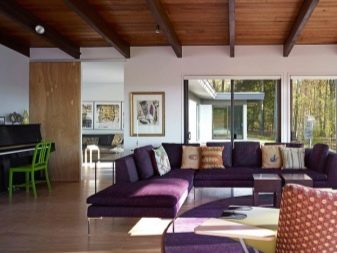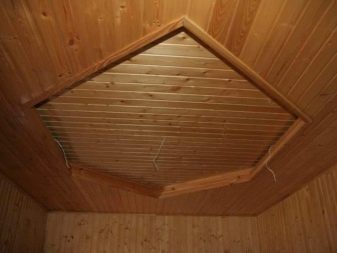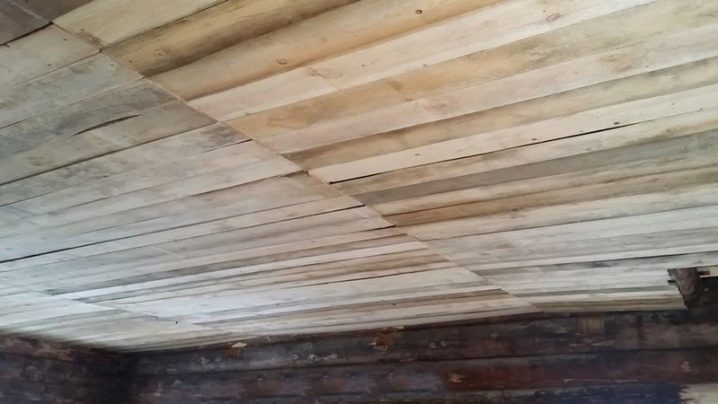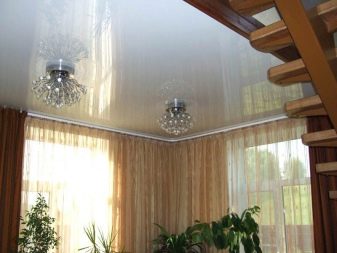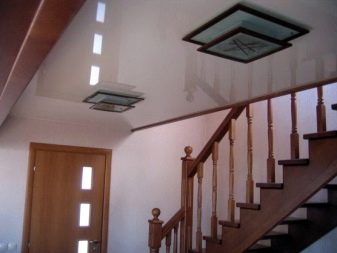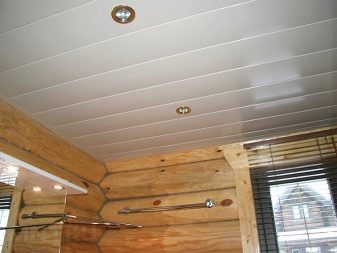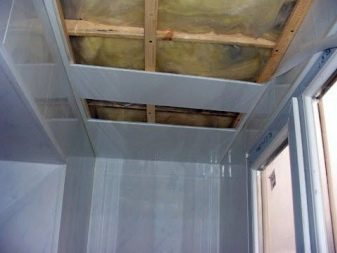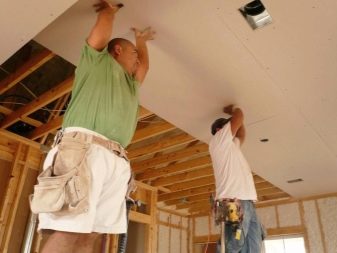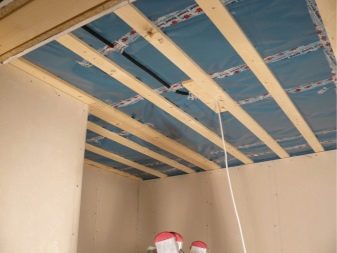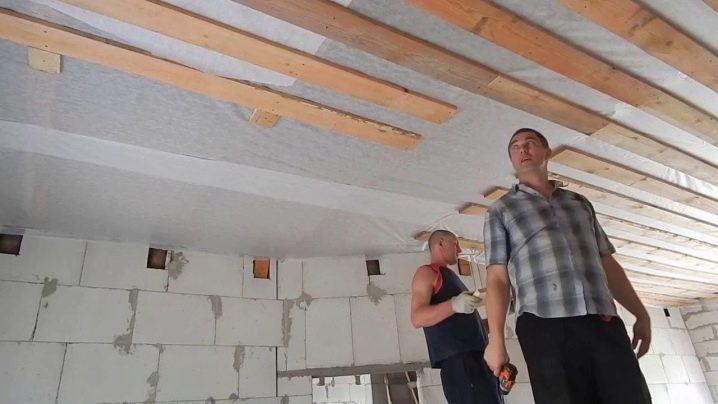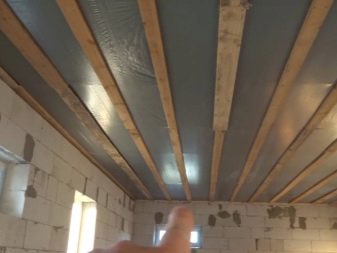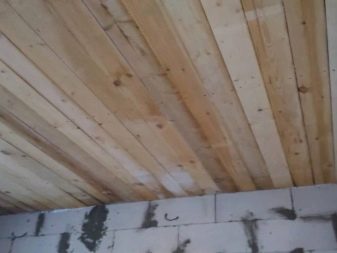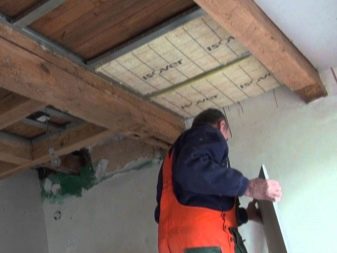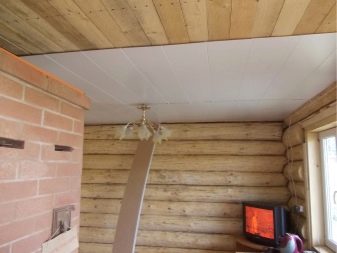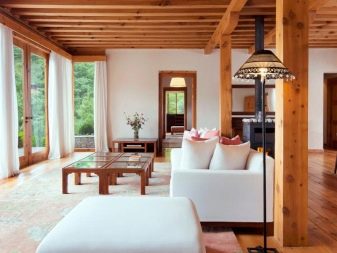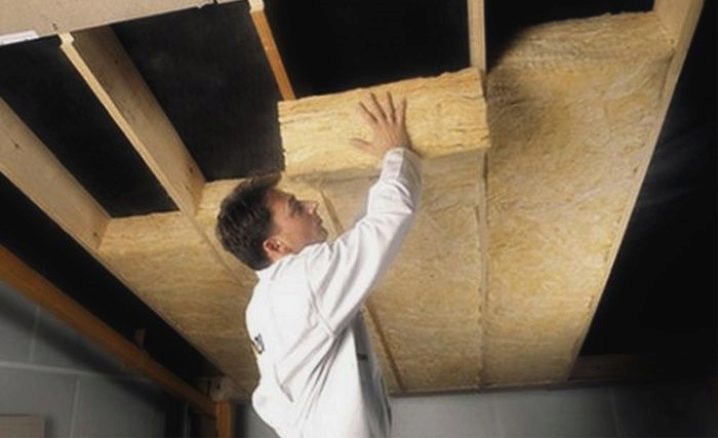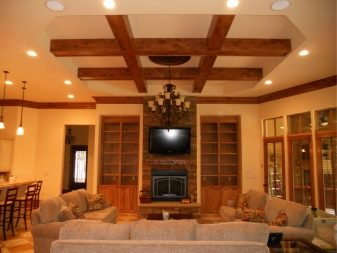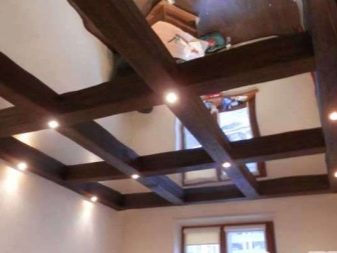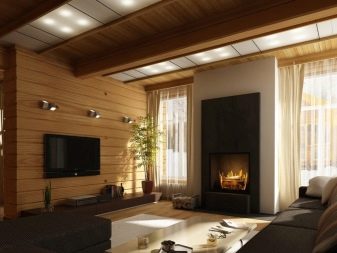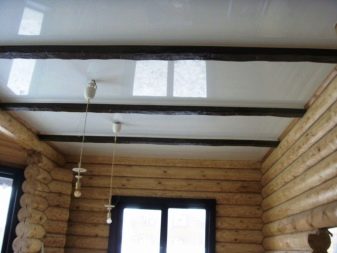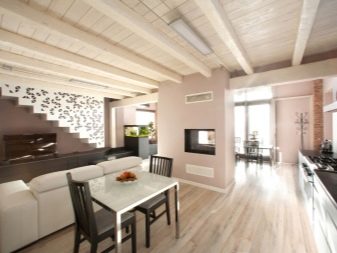Subtleties of filing ceiling on wooden beams
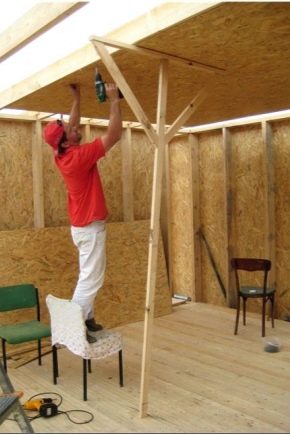
The foundations for interfloor ceilings and roofs in our country are made mostly of reinforced concrete or wood. For the construction of the roof, interfloor and attic floors use logs and rafters of edged boards 150 to 50 mm. The material for them is a cheap kind of wood (pine and spruce). On the brick and aerated concrete walls put a power plate around the perimeter of the building, which serves to fix the rafters and log. They are fastened to each other with the help of grooves made in the lock and fix their iron brackets tightening.
The modern form of fixation consists of reinforced iron corners and plates fastened with screws or nailed. Mauerlat can be made from the same edged board or from a bar, most often with the size of 150x150 mm or 150x200 mm. Lags may have the same size.
Often lags have the appearance of round timber, especially in rural areas. For outbuildings in the country or in the village in order to save and afford material rafters can also be made from not very thick round timber. Ideal quality evenness in such a design is difficult to achieve, but you can save a lot in financial terms.
Wood material should be used after proper storage so that there is no distortion and the board is not led by a screw. Kruglyak must be cleaned of bark.
Special features
In newbuilding, if it is not spontaneous, everything goes according to plan and according to the drawings. Questions arise during the repair or redevelopment of an existing premises. Especially if it was built without your participation.
Building a new one is always easier than repairing an old one. But this is not always beneficial from an economic point of view, and also requires a large amount of time.
Difficulties may arise if the room is used as a permanently inhabited. For repair it is necessary to free up the space where the work will take place. What could not bear, carefully covered with plastic film or sheets. Dismantling is in progress.
In the one-story house of an old building above the ceiling, there is likely to be a dry screed made of expanded clay or straw with clay. There will be a lot of dust.
In a two-storey building, it is not necessary to completely remove the ceiling for the first floor if there is a good floor on the upper floor. It will simply be harder to install heat and sound insulation from the mineral wool. It is inserted in stages as the ceiling is stitched, for fasteners use special plastic dowels with wide caps or tightening. The length of the dowels is cut slightly less than the thickness of the insulating material and is screwed to the floor of the upper floor with screws, about 1 cm longer than the length of the dowel.
The foam insulation is mounted in this situation much easier.
Materials
For this type of work fit any type of materials. You can combine several types at the same time. The ceiling can be made completely or partially flat. On such a surface wallpaper paste or ceiling foam tiles. And as an option, paint with oil or water-based paint.
Also used:
- Fiberboard. These sheets are covered in such a way that their ends run in the middle of the beam.For fixing the transverse ends between the beams, wooden bars of 20x40 mm are mounted. They can be fixed flush with the lags, cutting out the grooves in them or into the thrust using an additional bar or metal corner. During the work it is necessary to watch that the sheet DVP did not sag. Nail him with nails. Mounted sheets in a staggered manner, or simply with a displacement of the seam.
- Plywood. If you do not mind losing the texture of wood, then plywood sheets are nailed or attracted with screws in the same way as fiberboard. The only difference is in the thickness of the transverse bar, as plywood is heavier. Another thickness depends on the distance between the beams. When mounting with self-tapping screws, use a 2.5 mm pre-drill and flare hole to drown the screw head. The seams are filled with mastic or putty on wood. For paint primer and putty the entire surface. Primer is used universal, putty bespeschanka.
- OSB (OSB) plates. Inexpensive material with the strength, fastening and processing is the same as that of plywood. It has good moisture resistance. The disadvantage is the presence in the resin, gluing wood chips, a substance such as formaldehyde.But if the material is made with high quality, then formaldehyde emission is low. There are grooved plates with a groove-edge on the edge, thanks to which they are assembled as clapboard. The quality of the plates seam is practically absent.
- Drywall. The most common material for this purpose. It is easily mounted both on a wooden, and on an aluminum framework. Thanks to this, you can make a multi-level ceiling of it. If you need a small insert, it is easy to attach it directly to the draft ceiling. The peculiarity of its finishing is the sealing of the seams. To do this, use strips of fine mesh. It is moisture resistant from 10 mm thick for unheated rooms or rooms with low humidity. But for outdoor work and rooms with high humidity, it is not suitable. For warm and dry rooms there is a ceiling plasterboard with a thickness of 9 mm.
You can fill the ceiling with aerated concrete.
- Sandwich panels - good insulation. This option is used very rarely, because the panels are joined using an X-shaped plastic connector, and they are fastened to the logs with colored white paint self-tapping screws with a pressshayboy, which have nothing to cover.But as small inserts, they are very suitable. They are glossy and matte. Do not require additional processing. They are attached to the draft ceiling with liquid nails with the help of vertical struts extending from floor to ceiling.
- The most popular material for a private house is wooden lining. It is natural and environmentally friendly. The ceiling, hemmed by it, breathes, absorbing the excess moisture in the room and giving it up in case of shortage. In addition to the beautiful appearance, it is durable and plays the role of heat and sound insulation. The variety of texture of the tree from which it is made, gives a great choice for design decisions. They make it from coniferous and hardwood trees: oak, beech, ash, birch, linden, alder, pine, cedar. It differs by profile, grade and size. Width is from 30 mm to 150 mm. For the ceiling there is enough thickness of 12 mm. The standard length can be up to 6000 mm, which makes it possible to cover the room with one-piece slats without splicing. There is a large selection of wood stains, with the help of which they are made from cheap wood to make a color analogue expensive.
You can play with the texture of a tree with the help of varnish. For example, to lining is not yellow, it is first covered with a layer of nitrolac. It dries quickly without soaking the base, and creates a film.On top of the applied two layers of alkyd or waterborne varnish.
With the help of varnishes, you can make the surface glossy or matte. The lining is fastened to the groove in the groove, and to the logs with screws or nails, using a doboynik, at an angle of 45 degrees in the groove of the lining.
- As a hemmed material using a trim board. But this is more of a rough ceiling, because avoiding the gaps will not work. Usually inches (25 mm thickness) are hemmed into the entire length of the ceiling. Mount can be at 45 degrees in the side rail slats on the screed or through.
- Stretch ceiling looks beautiful (French). Installation of such a coating is done after the construction and finishing works. It’s easy to do it yourself without using gas equipment and heating guns. Although the temperature in the working room will have to raise in some way. From a special tool, you only need a spatula and a building dryer. Household or professional hair dryer is also suitable. The color and texture of the canvas is chosen to taste.
When purchasing components for installation, you need to buy superglue. Using another glue may damage the web.
First carried out and attached to the draft ceiling electrician.Then the installation is made according to the instructions, which is purchased with the accessories.
- Easy to mount on the ceiling plastic panels. They have an appearance of lining 50-100 mm wide. When assembled, they have a seam between them, so they are called slatted seams. For the ceiling fit lining with very thin walls. It is wrinkled even by hands and is afraid of mechanical loads, but it is light and does not require a reinforced frame for fastening. Usually it is white. Such material can be fixed to wooden beams even with a construction stapler. More dense plastic without suture panels. Their standard width is 250 mm, they are wider than 350 mm and 450 mm. They have a large selection of colors, from glossy white and matte to imitation of different types of wood.
Well suited for bathrooms, but not for a bath. They can be used not only for residential premises. They hem the ceiling on the veranda, gazebo, terrace, garage. Ennoble logs and beams that go beyond the wall as a visor.
They are fastened to the tree with small nails with a wide head, and on the metal profile with screws. They are easy to clean. Quality panels do not fade under the sun.
Siding and professional sheet can sheathe street structures: gazebos, garage, terrace, fence.Suspended ceilings, such as French, Armstrong, aluminum slats to beams have nothing to do. But it can be useful for design solutions - the device of such ceilings can be combined with other materials.
Structures
We considered the materials attached to the beams and closing them completely. To increase the space and create a special design beams can be left open. They can be decorated with hand-carved and varnished.
If they are solid, then you can leave them without additional machining. When they are prefabricated or look ugly, they are sewn up with other material. Old beams are cleaned of mold and mildew, treated with flame retardant and bioprotective impregnation.
The scheme of interfloor and roofing overlapping is one:
- ceiling. It happens rough and finish;
- steam and waterproofing. Used non-woven films, films with foil, having a polymer reinforcing frame. It prevents the occurrence of mold and mildew, interferes with the absorption of moisture by the insulation, improves thermal insulation;
- insulation. Polymeric material is used: polystyrene foam, polyurethane foam, polystyrene foam. Organic: peat, straw, sawdust.Inorganic: expanded clay, perlite, vermiculite, mineral wool. It allows you to keep warm and serves as sound insulation;
- waterproofing. Apply polypropylene films, roofing felt, glassine, polyethylene. It prevents the penetration of moisture into the insulation and wooden structures;
- floor or roof. For the floor using flooring or edging board, chipboard, OSB, paneling, plywood. For the roof: slate, metal roofing, corrugated board, flexible tile.
Design features - using draft ceiling or without it. It is required if organic material is used as insulation. It is also needed when covering the ceiling with sheets of fiberboard. If it is crooked, it should be aligned.
How to hem?
As the ceiling, you can use the floor of the upper floor. The selected material is pre-treated with antiseptic and placed on top of the floor beams. Thus, the ceiling becomes higher, and the beams become part of the interior.
On the ceiling (floor) is mounted lathing under the finishing floor of the upper floor. Then everything goes on technology: vapor barrier, insulation, waterproofing, floor.
To leave the beams outside and save space in the upper room, a quarter is made in the upper part, the depth of which will consist of the thickness of the material of the ceiling plus the thickness of the insulation. A quarter can be made in advance with a circular saw before mounting the beams or using a chainsaw in place. The material of the ceiling is cut in thrust and placed a quarter between the beams. Further work is being done on technology.
If you don't want to mess around with a quarter, it is possible to knock a beam in the form of a baget (ceiling plinth) along the beams, and on it to put the ceiling material. The clapboard can be fastened to the bar from the butt at 45 degrees, and the OSB, plywood and drywall - through.
When it is necessary to insulate the lower room for interior decoration, but there is still no material for ceiling filing, you can insulate it with mineral wool. For this purpose, a dense polypropylene film is knocked to the beams using a construction stapler. Overlap with 25-50 cm overlap, wrapping the edges on the wall, and the seams go through with metallic tape. At the bottom they make a counter grill for the future ceiling. Minvatu pruned and put between the beams on the film. Top closed waterproofing.
Design solutions for filing the ceiling can be expressed in a combination of different types of material that can be given unusual shapes using electric lighting in different levels and directions.
Looks very nice ceiling with elements of mirror coatings. This solution allows you to increase the illumination of the room, select any part of the interior: a chandelier, a bed, a desk, a corner, a walkway.
Materials with a reflective surface:
- Glass-Based Ordinary Mirror. The installation of such elements is expensive, the material is fragile and has a certain weight. But mirrors reflect light better than other materials. Glued on liquid nails.
- Stretch mirror cloth. The maximum width of the film is 1.3 m, it is difficult to mount, because it does not stretch. Excellent reflective ratio. For small areas on the ceiling is perfect. There are also stretch PVC glossy films coated with varnish. They only reflect the surface without a clean specularity.
- Plexiglass. It is made according to the technology of ordinary glass, instead of which transparent acrylic plastic is used. There are also plastic sheets with glued mirror film.They are light and durable. Mounted as a false ceiling.
- Aluminum slatted and cassette ceilings. Unfortunately, the slats are easily scratched.
Useful tips
If there is no special antiseptic, wood can be impregnated with mining. It is an engine oil that has worked its life. Such impregnation protects wood, saves oil paint when it is used.
Polyethylene film for vapor barrier ceiling near the roof is ineffectivebecause it creates complete tightness. Because of this, there is a greenhouse process that promotes the accumulation of fluid, which, due to the temperature difference, destroys the properties of the insulation and provokes damage to the wood. Polypropylene film having a foil-coated coating should have a space between 1-2 cm of insulation for ventilation. It is attached with a foil to the outside.
To avoid mistakes during installation, it is better to use Izospan material.. It is inexpensive and can closely fit to the insulation. The only concern is not purchased Izospan hydro-insulating. It is necessary to pay more attention to the tightness of the joints of the film strips. To do this, use a wide adhesive tape, and the places of the joints should be chosen on the logs.
How to hem the ceiling on the wooden beams, see the following video.
